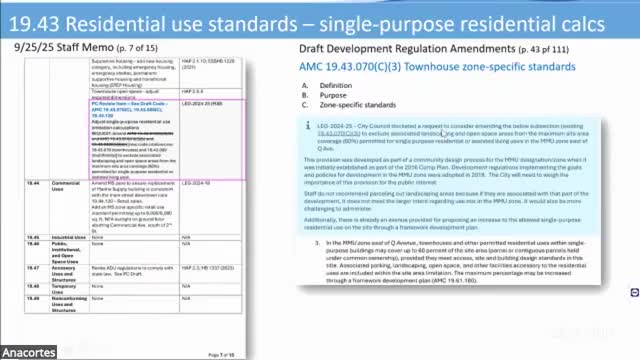Development Proposal Seeks Exemption for Landscaping from Residential Density Restrictions
October 02, 2025 | Anacortes, Skagit County, Washington
This article was created by AI summarizing key points discussed. AI makes mistakes, so for full details and context, please refer to the video of the full meeting. Please report any errors so we can fix them. Report an error »

In the heart of Anacortes, city planners gathered to discuss a pivotal proposal that could reshape the landscape of residential development. The Planning Commission meeting on October 1, 2025, brought to light a request from MJB, a developer seeking to amend the current zoning code regarding landscaping and open space requirements for residential projects.
As the discussion unfolded, Libby, a city planner, introduced the proposal to exclude landscaping and open space from the 60% maximum development cap for townhouses, assisted living facilities, and multifamily buildings. This change aims to encourage more green spaces and parks within residential areas, rather than relegating them to commercial zones, which has been the unintended consequence of the existing regulations.
Jimmy, representing MJB, elaborated on the issue, explaining that the current code inadvertently discourages the inclusion of landscaping and open spaces in residential developments. He emphasized that if a 10,000 square foot park were added to a multifamily building, it would count against the total area available for residential development, thus limiting the potential for cohesive and community-friendly designs.
The conversation highlighted the complexities of the zoning code, with city staff expressing concerns about the implications of such a change. They argued that maintaining landscaping as part of the residential development is essential for meeting the broader goals of the marine mixed-use zone. However, a potential compromise emerged during the dialogue: allowing landscaping and open space that exceeds minimum requirements to be excluded from the 60% cap. This middle ground could foster more parks and green areas without compromising the residential capacity of the site.
As the meeting progressed, the commission acknowledged the need for clarity in the language of the code to ensure that any changes would be practical and beneficial for the community. The discussions around balcony projections and site planning standards also underscored the importance of compatibility between new developments and existing properties.
The outcome of this meeting could significantly influence the future of Anacortes, shaping not only the physical environment but also the quality of life for its residents. As the city navigates these complex zoning issues, the hope remains that thoughtful planning will lead to a more vibrant and sustainable community.
As the discussion unfolded, Libby, a city planner, introduced the proposal to exclude landscaping and open space from the 60% maximum development cap for townhouses, assisted living facilities, and multifamily buildings. This change aims to encourage more green spaces and parks within residential areas, rather than relegating them to commercial zones, which has been the unintended consequence of the existing regulations.
Jimmy, representing MJB, elaborated on the issue, explaining that the current code inadvertently discourages the inclusion of landscaping and open spaces in residential developments. He emphasized that if a 10,000 square foot park were added to a multifamily building, it would count against the total area available for residential development, thus limiting the potential for cohesive and community-friendly designs.
The conversation highlighted the complexities of the zoning code, with city staff expressing concerns about the implications of such a change. They argued that maintaining landscaping as part of the residential development is essential for meeting the broader goals of the marine mixed-use zone. However, a potential compromise emerged during the dialogue: allowing landscaping and open space that exceeds minimum requirements to be excluded from the 60% cap. This middle ground could foster more parks and green areas without compromising the residential capacity of the site.
As the meeting progressed, the commission acknowledged the need for clarity in the language of the code to ensure that any changes would be practical and beneficial for the community. The discussions around balcony projections and site planning standards also underscored the importance of compatibility between new developments and existing properties.
The outcome of this meeting could significantly influence the future of Anacortes, shaping not only the physical environment but also the quality of life for its residents. As the city navigates these complex zoning issues, the hope remains that thoughtful planning will lead to a more vibrant and sustainable community.
View full meeting
This article is based on a recent meeting—watch the full video and explore the complete transcript for deeper insights into the discussion.
View full meeting
